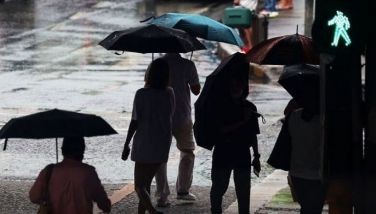Heeding Nature’s signs: How natives gird for floods, quakes
December 29, 2003 | 12:00am
LOS BAÑOS, Laguna — With the country’s mountains now very brittle because of the wanton destruction of forest resources, authorities can learn from "folk wisdom" crystallized over decades by cultural communities in predicting calamities such as killer floods and earthquakes.
This is particularly useful in parts of the country where forests have been considerably denuded and thus, are prone to catastrophes such as the killer floods that struck Ormoc City in 1991.
Warning signs of natural disasters taken seriously by cultural communities have been compiled by the Department of Science and Technology-Philippine Institute of Volcanology and Seismology (DOST-Phivolcs) in collaboration with the Ugnayang Pang-agham Tao Foundation Inc. (UGAT).
The project was funded by the Los Baños-based Philippine Council for Agriculture, Forestry and Natural Resources Research and Development (PCARRD) of the DOST.
To indigenous communities in various parts of the country, strange behaviors of animals are omens of forthcoming danger, noted Phivolcs and UGAT, as reported by PCARRD’s Alexandra Cabrera.
To Ifugaos of the Cordilleras, for instance, floods are forthcoming when the bird salaksak begins crying in the trees and the pato (wild duck) flies to the mountains.
The same is true with Mangyans in the northeastern part of Mindoro. When shellfish crawls out of the water on to the riverbanks, the Irayas of Abra de Ilog, Mamburao and Paluan prepare for floods. On the other hand, when shrimps jump out of the water, this is a sign of an impending flood for the Tadyawans.
The appearance of the bird mohen signals a forthcoming flood to the coast-dwelling T’bolis of South Cotabato.
Signs of floods to the Mandayas ("the first people upstream") in Compostela Valley are dark clouds, frequent thunder and lightning, and gamu-gamu (moths) flying around in flocks. Mournful sounds by the birds kigid and alimokon also foretell floods.
The Maguindanaoans consider the flowering of the mango tree immediately after a harvest as a sign of a forthcoming flood. The Maguindanaoans ("people of the flood plain") are scattered in the provinces of Maguindanao, North Cotabato, South Cotabato and Sultan Kudarat, mostly living in the Pulangi River Valley which is occasionally flooded.
Another PCARRD-monitored project conducted by Phivolcs with DOST funding support noted that some cultural communities "see" portents of destructive natural calamities written in the skies.
For instance, they use the color and type of clouds, wind direction, and the stars’ position to predict rains or storms.
Also, they forecast drought by the position of the constellations (configurations of stars). They likewise see an impending earthquake, the coming of rains or storms, and floods in the unusual behaviors of animals.
Titled "Natural disaster management among Filipino cultural communities" and done by a team headed by Dr. Jean Tayag, the study delved into the indigenous people’s methods of predicting and managing natural disasters.
For their respondents, the Phivolcs researchers selected cultural communities with a population of more than 200,000 living in areas prone to natural hazards. They also preferred communities with available historical accounts or resource persons.
This is particularly useful in parts of the country where forests have been considerably denuded and thus, are prone to catastrophes such as the killer floods that struck Ormoc City in 1991.
Warning signs of natural disasters taken seriously by cultural communities have been compiled by the Department of Science and Technology-Philippine Institute of Volcanology and Seismology (DOST-Phivolcs) in collaboration with the Ugnayang Pang-agham Tao Foundation Inc. (UGAT).
The project was funded by the Los Baños-based Philippine Council for Agriculture, Forestry and Natural Resources Research and Development (PCARRD) of the DOST.
To indigenous communities in various parts of the country, strange behaviors of animals are omens of forthcoming danger, noted Phivolcs and UGAT, as reported by PCARRD’s Alexandra Cabrera.
The same is true with Mangyans in the northeastern part of Mindoro. When shellfish crawls out of the water on to the riverbanks, the Irayas of Abra de Ilog, Mamburao and Paluan prepare for floods. On the other hand, when shrimps jump out of the water, this is a sign of an impending flood for the Tadyawans.
The appearance of the bird mohen signals a forthcoming flood to the coast-dwelling T’bolis of South Cotabato.
Signs of floods to the Mandayas ("the first people upstream") in Compostela Valley are dark clouds, frequent thunder and lightning, and gamu-gamu (moths) flying around in flocks. Mournful sounds by the birds kigid and alimokon also foretell floods.
The Maguindanaoans consider the flowering of the mango tree immediately after a harvest as a sign of a forthcoming flood. The Maguindanaoans ("people of the flood plain") are scattered in the provinces of Maguindanao, North Cotabato, South Cotabato and Sultan Kudarat, mostly living in the Pulangi River Valley which is occasionally flooded.
For instance, they use the color and type of clouds, wind direction, and the stars’ position to predict rains or storms.
Also, they forecast drought by the position of the constellations (configurations of stars). They likewise see an impending earthquake, the coming of rains or storms, and floods in the unusual behaviors of animals.
Titled "Natural disaster management among Filipino cultural communities" and done by a team headed by Dr. Jean Tayag, the study delved into the indigenous people’s methods of predicting and managing natural disasters.
For their respondents, the Phivolcs researchers selected cultural communities with a population of more than 200,000 living in areas prone to natural hazards. They also preferred communities with available historical accounts or resource persons.
BrandSpace Articles
<
>
- Latest
- Trending
Trending
Latest
Trending
Latest
Recommended






























